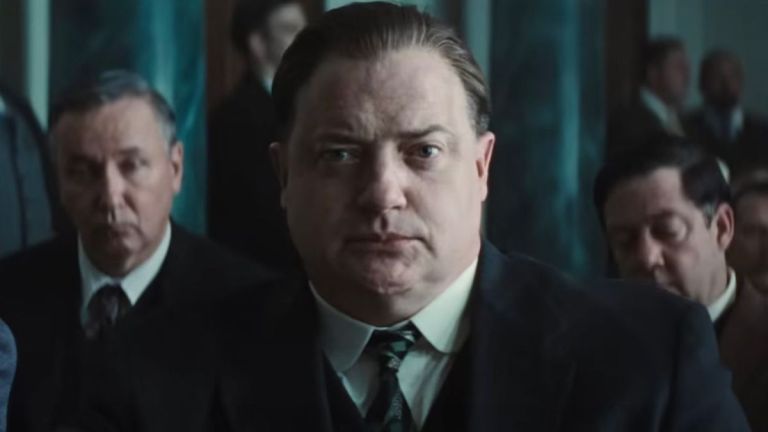Brendan Fraser’s Killers of the Flower Moon Scenes Are Better Than You Realize
Brendan Fraser feels like he's coming from a completely different kind of movie in Martin Scorsese's Killers of the Flower Moon, and that's what makes this big swing so good.

This article contains Killers of the Flower Moon spoilers.
Silence greets Ernest Burkhart when he enters a meeting with the business leaders of Osage County, Oklahoma. This late into Martin Scorsese’s Killers of the Flower Moon, Ernest (Leonardo DiCaprio) has proven to be easily pliable, to the point that his uncle William “King” Hale (Robert De Niro) can convince him to poison his beloved wife Mollie (Lily Gladstone). But he can be pushed only so far. If the leaders do not want Ernest to testify against his uncle, they must be subtle.
Thus the quiet when Ernest enters the room, which Scorsese and his cinematographer Rodrigo Prieto shoot like a baroque painting. The low mumble of their conversation fades as each withered white face turns from the shadows to face Ernest, who nods in a suggestion of understanding.
But the quiet breaks when W.S. Hamilton, the lawyer for Hale and Ernest, stands before the man and lays things out plainly. The hulking Hamilton, played by Brendan Fraser, looks down on Ernest and declares/asks, “If you testify against your uncle, you realize this can be held against you for the rest of your life.” Hamilton attempts to hold his voice to a whisper, but he cannot refrain from gesticulating with his massive hands. Frustrated that Ernest doesn’t comprehend his point, Hamilton finally lets his voice free, stabbing his finger into his so-called client’s face as he states, “Ernest! If you do that, you will be murdering your uncle!”
Fraser’s take on Hamilton is incongruous with the rest of the film. It’s big, loud, and wholly artificial. And it’s perfect.
Breaking the Silence, Breaking the Scene
For some viewers, Hamilton’s behavior breaks Killers of the Flower Moon. Based on the book by journalist David Grann, and adapted for the screen by Scorsese and Eric Roth, Killers of the Flower Moon tells the shameful true story of white Americans who conspired to steal wealth that the Osage Nation gained by selling the oil on their land. White men like Ernest would marry Osage women like Mollie and then murder them, inheriting their headrights portion of the land, and thereby their money.
Such terrible actions, less than 100 years old and only one of many crimes white Americans have committed against Indigenous peoples, deserve to be treated with solemnity. And most of the film meets that expectation. DiCaprio works against his movie star charisma to portray Ernest as a dour doofus. De Niro and Jesse Plemons, who enters late in the film as Bureau of Investigation Agent Tom White, speak in hushed tones about schemes and investigations. And breakout star Lily Gladstone (at least for those who missed her star-making turn in Kelly Reichardt’s Certain Women) conveys wells of hurt, joy, and anger with little more than a glance.
Fraser is having none of it. He first appears in the movie as the camera follows Ernest into the courtroom in a tracking shot set to the driving rhythm of the late Robbie Robertson’s score. As Ernest makes his way in front of the judge, the camera turns 360 degrees to find Hamilton sitting next to Hale and glaring at his alleged client. The score drops out, leaving only the soft rumbling of the crowd, which itself fades into silence.
At least until Hamilton bellows, “I demand to confer privately with Mr. Burkhart!” The camera follows Frasier as he stands, forcing the viewers to look up at his massive frame as Hamilton bullies his way through the proceedings. Fraser’s voice cracks and his face twists into outrageous arrangements, overpowering even noted scenery-chewer John Lithgow, who portrays the prosecutor Peter Leaward.
Fraser’s interruption of the proceedings dominates the movie, calling attention to both the actor and his character’s statements, and away from the crimes and the legal proceedings. Which is, of course, the point.
Loudly Rejecting Realism
Fraser is hardly the only surprising face in Killers of the Flower Moon. Country musician Jason Isbell plays an important role in the first half of the movie as Bill Smith, a possible conspirator, or at least another white man who married Osage women for their money, whom Hale has killed after he starts asking too many questions. Fellow musician Jack White shows up as one of the actors performing a radio drama about the Osage murders at the end of the movie, set sometime after the events. And of course, the radio drama ends with Scorsese himself walking on stage to read the last lines of the film.
Scorsese’s appearance and Fraser’s performance work in tandem to underscore one of the main themes of the movie. While this picture is about crimes done to the Osage people, and employs many Indigenous actors, it still centers white people. Thus the central tension is not about who is killing Mollie’s people, as Scorsese makes the perpetrators clear from the beginning. Rather the question is about whether or not white people will confess their crimes, seek justice, and remit reparations.
When Scorsese takes the stage at the end of the film, he highlights the limits of the portrayal that we just watched, reminding us that it comes from his perspective and does not contain the full, unprejudiced truth of the events. Fraser’s performance has a similar, but less subtle, effect. As Scorsese told Variety, he cast Fraser to play a lawyer precisely because of the actor’s size. “[H]e had that girth,” Scorsese enthused. “He’s big in the frame at that time.”
That girth and boisterousness helps add another wrinkle to the lack of reality that Scorsese maintains throughout the film. Because we’re not seeing the truth unvarnished and as it is, different people will have different motivations for telling the story.
Fraser plays Hamilton as the paradigmatic white American, a man who bullies anyone who would tell a story differently from him. Sure, Hamilton invokes legal structures and insists that he’s well within his rights to behave the way he does. But Fraser plays him not as a silver-tongued orator, but as a thug, just another one of the goons in Hale’s employ.
Learning to Listen
Like the book on which it is based, Killers of the Flower Moon tells a story that has been kept quiet for far too long. But as is so often the case when someone speaks for justice, people have tried to silence those who would tell the story of American crimes against Indigenous peoples—sometimes by dismissing the tale, more often by talking over it.
With his loud and obnoxious portrayal of a lawyer who fought to uphold white supremacy, Fraser represents those who would talk over the Osage and against those who condemn white America’s transgressions. His bellowing makes us want to close our ears against Hamilton’s shouting, which is exactly what Scorsese intends—provided we go past even his descriptions and listen to the victims, listen to the Osage themselves.
